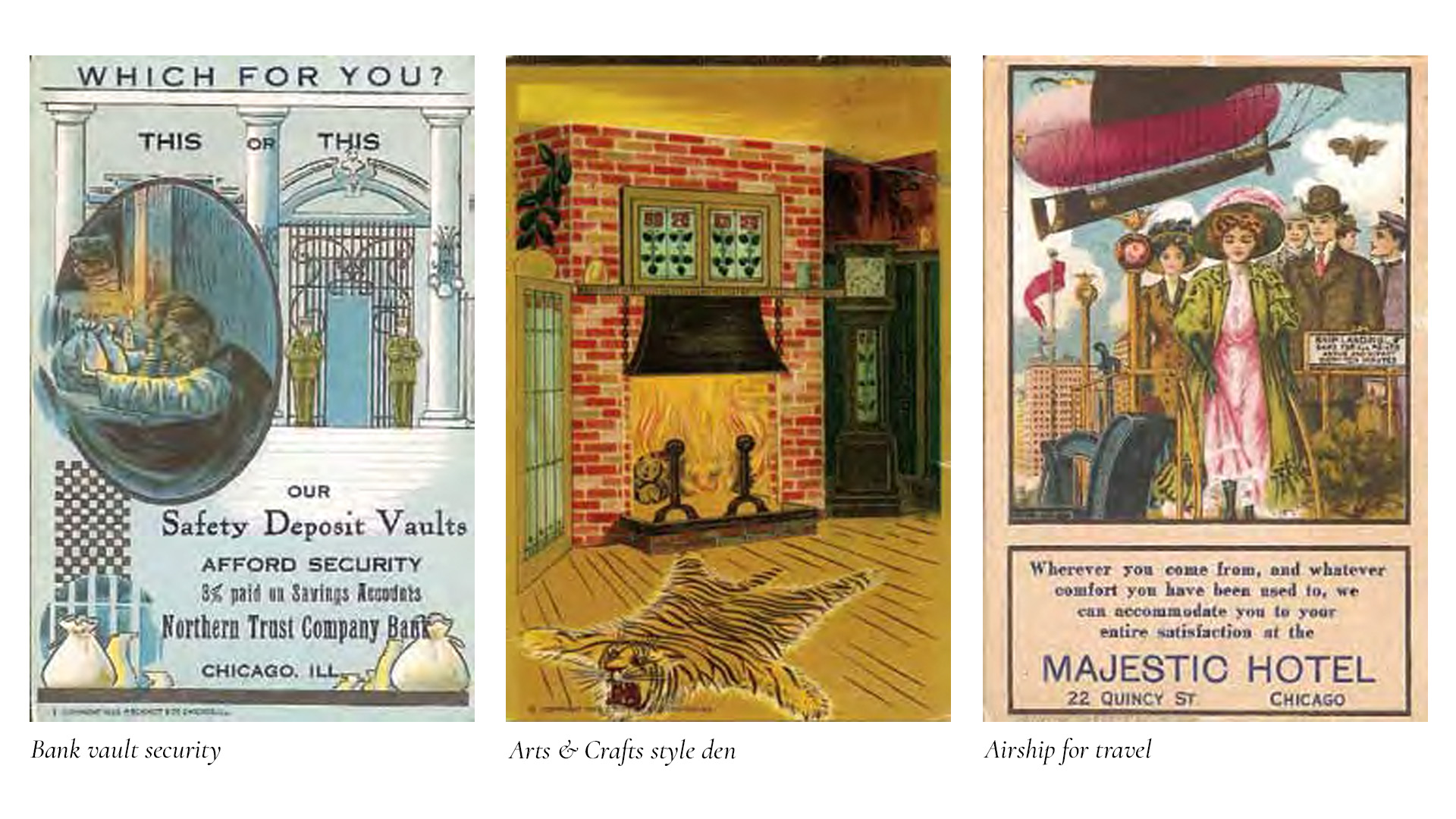The Postcard Quest for Arts & Crafts Imagery
March/April 2013. Vol. 4, No. 2
By Susan Hack-Lane
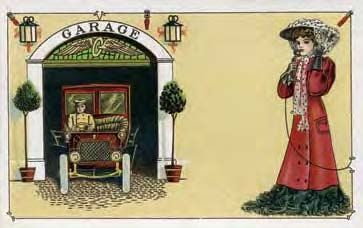
Garage, chauffeur on call
As collectors we spend a good deal of time seeking that alluring postcard. Even after the purchase we are caught in a web of intrigue, trying to sort out whether the card is a single stand-alone postcard or a card within a set. With this comes the thought that there could be companion cards of equal appeal. In pursuit I have all too often found that I have fallen upon an extended search and so it is that I expand my holdings to an endless variety of cards, cards that complete a set or series.
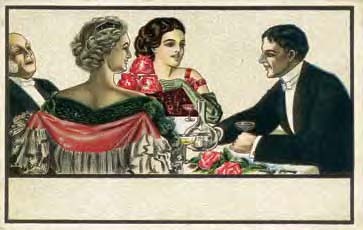
Dinner party
Long ago I started with one card that fit into my textile collection, not knowing that such a quest was before me. It was much later that I grasped the extent of this prized set of advertising cards done by the publisher P. Schmidt & Company of Chicago, Illinois. The pictured images are intriguing, catering to men or women, and each detailed in design. As a series described by its Arts & Crafts artistry it is a superb collection. The Arts and Crafts period refers to a time and philosophy of decorative art work where the quality of the craftsmanship is the primary factor. Consider William Morris prints from England, America’s Mission Style furniture, and embroidery (as well as books and postcards) by the publisher Volland & Company.
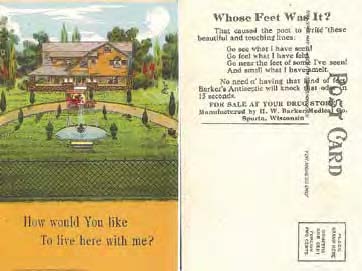
Landscaped estate & reverse advertisement
Facts about P. Schmidt & Co. cards are few. Published with a copyright date of 1909, the series has 64 postcards with each card numbered on the front or the reverse along with copyright information. For those intrigued by variations, we know that each card was produced with the front and reverse format. The artist has not been identified, but it appears that all cards were done by one illustrator taking some liberty in artistic style. As a promotional postcard, each card was a retail give-away resulting in some cards being harder to find. Other cards are more expensive because they relate to fire and sports or show domestic workers. However, the cards that are the most difficult to find are those with advertising messages.
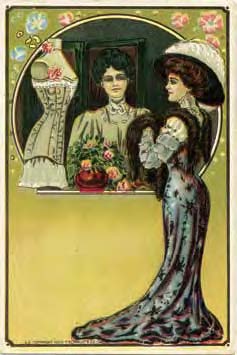
Fashion and form
Without text or lettering, the postcards are questionably referred to as poster-like. Proposed as advertising cards, they were designed with a blank area or banner for retail customers to create their own wording. This was accomplished with an overprint of an advertising message or of a calling-card date, but the odd card exists with a hand-written name or message inscribed. Some cards with face advertising also have lengthy, sometimes humorous to us now, and somewhat difficult to read, advertising messages on the reverse. One establishment had a monopoly on card 35. This card showing a stage act only appears with an overprint message advertising The States Restaurant and the eatery’s vaudeville act. Variations in this restaurant’s advertising message show up as a result of multiple print runs.
Schmidt must have produced a substantial number of cards. One private printer offered them to retailers by promoting them on the reverse of a sample card in quantities of 1000, 5000 and 10,000 at prices of $5.00, $4.25, and $3.75 per 1000, respectively. Customers would likely have been restaurants and retail stores, but consider that pictures also depict bank security, a concert hall, sailboats, toys, coal delivery. . . and so much more.
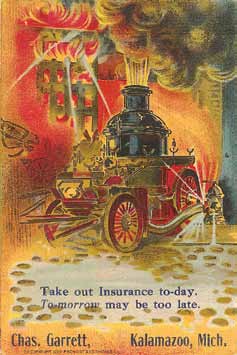
Fire pump to the rescue
Each card keeps to the theme of the genteel, upper-class domestic life at the beginning of the 20th century. Going out to the theater, the gentleman sports his tux and the lady of the house wraps herself in fur. This is after she picks out her wallpaper, china, crystal and cutlery, assesses measurements for an oriental rug, secures proper fire insurance, receives a floral delivery and has her nails manicured. In fact, the proprietor of the golf course and the lumber yard own fine equipment and their acreage too is manicured. I wonder how it could be that I once pictured a single Chicago department store distributing these cards, having 64 different departments, and each department devoted to the card’s imagery. This was not the case. Spiegel yes, but Schmidt no.
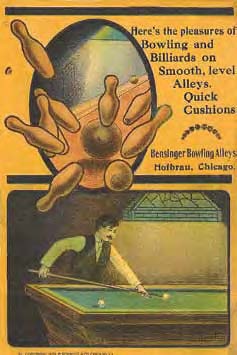
Billiards and bowling
Turn the cards over. Like most correspondence of that time, we read about planned visits, regards, baked goods and canning, along with the number of chicks and hens at home or on the farm. One gem was sent from Pauline in Marion, Indiana to her cousin James in Rockford, Ohio in early July with an invitation to a July 4th celebration. It reads “Does Francis have to go to war? There has been ten car load of boys thru here from Mass.” Going west were they off to a military camp for training? Were all deployed? Did each and every lad return safely to their homes in Massachusetts? As to where to find these cards, check under Advertising or Schmidt, but do not forget Occupations, Poster Art, Art Nouveau, Art Deco, and Arts & Crafts or a host of other mismatched categories. My very first card was found filed under Fantasy. It showed the fineness and the source of silk sewing thread when comparing it with a spider’s web. This card could just as easily have been filed under Spinning, which is where I first placed it when I got it home.
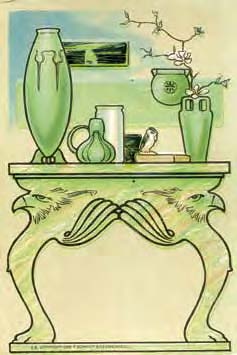
Craftsmanship, decorative arts accessories
I know that Schmidt cards continue to be appreciated for I am not the only one carrying a want-list. The cards are sought-after by those filling in after many years of searching and by those in search of an upgrade. Some look for postcards that have been postally used, others for mint cards, while those looking for variations seek numbered fronts and numbered backs or the elusive cards with commercial advertising.And then there are new collectors seeking examples of Arts & Crafts style advertising and a good long search.
(1) Kay Stansbury wrote about the series and compiled a checklist, published in the December 1986 issue of the now defunct magazine Postcard Collector. Images were not included.
(2) Thanks are due to Dennis Goreham, Ray Hahn, Jill Klein, Elaine Luck, John Monroe and Hal Ottaway for sharing information and images as well as attending to many want-lists.

